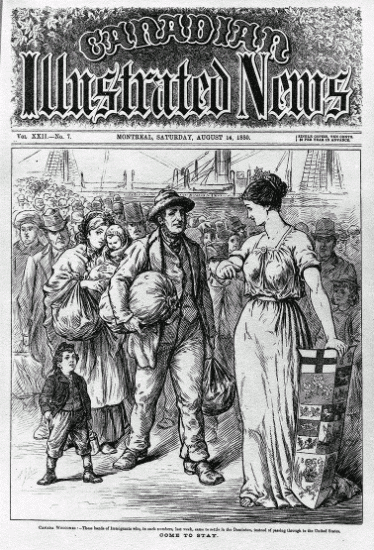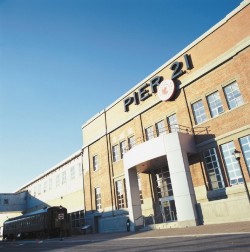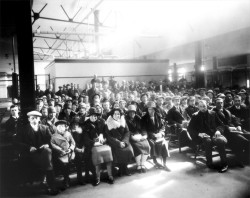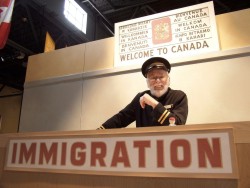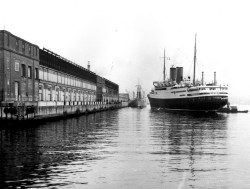|
||||
|
Questions with Immigration?
|
|
A Visit to Historic Pier 21 Immigrant Museum -
The people who arrived at Pier 21 on the Halifax waterfront changed the face of Canada and today it is one of the most multi-ethnic countries in the world. In fact, 20 per cent of Canadians have a direct link to Pier 21. The Pier 21 National Historic Site, located at the same point where almost 1.5 million immigrants landed in Canada between 1928 and 1971, is a must-see for Maritimes vacationers. Visitors are able to read the names of thousands of people who are permanently etched into the walls of Pier 21 in the former immigration shed transformed into a museum. A computer kiosk helps them find a particular brick where they can also read family biographies of those who wish to share their family history.
The Red Cross operated a nursery at Pier 21, so that families with small children could bathe them and rest before boarding the train for the next stage of their journey to other parts of Canada where they would start new lives. “We came in February with no winter clothes or rubbers,” one refugee would recall later about her first meeting with a representative of the International Refugee Organization at Pier 21. “Our little daughter looked very hungry and miserable. He took us into his office and sent out for cocoa and fig Newton cookies. As long as I live, I’ll never forget how good those cookies tasted to us.” During the Second World War, ocean liners that once arrived full of eager immigrants were transformed into troopships. In all, 494,874 troops departed from Pier 21 to serve on the European front. When the war was over, 48,000 war brides and their 22,000 children made the journey to Canada and began new lives with their Canadian husbands. In the research library, I attempted to look up the date of arrival of my father-in-law, who came to Canada with his mother from Czechoslovakia in 1937, only to find out that they had landed in Montreal and were not in the data base. However, even information on newcomers who landed in other ports can be secured by contacting Citizenship and Immigration Canada in Ottawa.
In an editorial written for the Winnipeg Free Press, Rev. Karen E. Poole said all Canadians should be required to visit the site. “It should be put on our required list in order to be a citizen,” she wrote. “If we did, it could well be the end of prejudice, bigotry and hate; because we are all rooted in an entry port, like the gates of heaven to a whole new world, like a paradise, where not one of us felt at home, yet every one of us was an immigrant seeking a home, unless indigenous and offering hospitality.” Tour ships still dock at the same place today, and their passengers make up a huge portion of the clientele at Pavilion 22, where a variety of unique retailers peddle local products like handmade jewelry, handcrafted goods, signature products, silks, knits, Nova Scotia tartans and T-shirts. The pavilion is located adjacent to Pier 21. We
followed the boardwalk all the way along the waterfront
to the Maritime Museum of the Atlantic and the HMCS
Sackville, passing many tall ships moored in the harbor.
The award-winning museum displays the nautical and
marine history of Atlantic Canada. Major exhibits
include the relics of the Titanic, Shipwreck Treasures
of Nova Scotia, the Story of the Halifax Explosion and
North Atlantic Convoys. We booked a small suite in a dorm at Mount St. Vincent University. The university campus is located in Bedford, just north of the city. Once owned by the Sisters of Charity, it is now a co-educational institution with about 5,000 students. For $75 a night, you get a little suite with two bedrooms and private bathroom. There is a kitchen and TV room at the end of each hall. A full scale breakfast is included in the price and guests are welcome to use the internet service. We found it exciting to be near the terminal where large ocean-going freighters are loaded and unloaded every day at one Halifax’s two container terminals on the Bedford Basin, just across the road from the university. During the First and Second World Wars, the protected waters of the basin were and ideal location for the Royal Canadian Navy to assemble convoys consisting of hundreds of merchant ships to fight the Germans. From
Mount Saint Vincent, it is easy to jump on Route 102 and
head north to Truro, Antigonish and Cape Breton or take
Route 103 west to Peggy’s Cove, Mahone Bay and
Lunenberg. Mahone Bay is a marvelous location for artists with its harbor and white sailboats dotted against a background of pastel-colored storefronts. A cluster of small and medium-sized islands provide shelter for pleasure cruising yachts. The original Bluenose was built in Lunenburg and one of its successors, the Bluenose II, still takes tourists out for sails on the Atlantic. One of the highlights of the summer season in Lunenburg is the Lunenburg Folk Festival, scheduled this year for Aug. 7-10. Besides an offering of both seasoned and local folk artists, the festival has a variety of workshops on storytelling, dance, children’s songs and songwriting. Denis Gibbons is a freelance travel writer residing in Burlington, Ontario.
Driving
directions to Pier 21: It is longer than the route through the U.S., in which you cross over at Cornwall, and pass through New York, Vermont New Hampshire and Maine into New Brunswick, but the roads are much better and there is more choice of accommodation. Air Canada and other carriers also have daily flights out of Toronto’s Pearson International Airport |
||
|
Home
Immigrant Stories
Resources
Education
Relationships
Travel
Special Features |
||||


